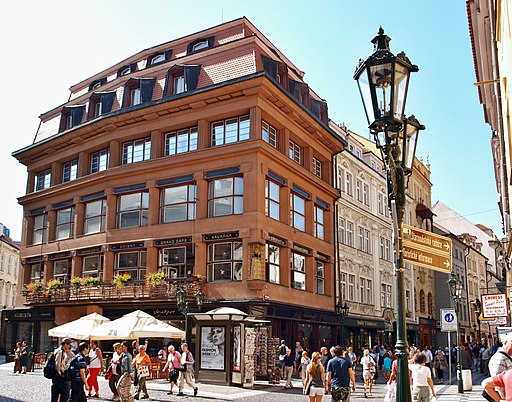Explore the less-known aspect of Prague that makes its architecture truly unique.
Cubism was an early-20th-century style pioneered by Georges Braque and Pablo Picasso. Despite its huge impact on the development of modern art, it remained primarily limited to paintings and sculptures. The Czech Republic is the only country in the world that developed Cubist ideas also in architecture. Here is a selection of 7 most interesting Cubist sights that you can find in Prague:
House of the black Madonna (map)
This monumental building at the corner of Celetná and Ovocný trh streets in the Old Town of Prague is the very first Cubist house in the world. It was designed by Josef Gočár in 1911 and is the symbol of Czech Cubism. The building hosts the museum of Czech Cubism and Grand Cafe Orient, the only Cubist cafe in the world!
Cubist lamp post (map)
The only Cubist lamp post in the world is situated in a little backyard behind Wenceslas Square, surrounded by an eclectic combination of Functional, Gothic and Baroque architecture. It is made of geometrical chunks of concrete and the top resembles a diamond. The architect Emil Králiček designed it in 1912.
“Diamant” House (map)
Emil Králiček’s fascination with the shape of the diamond is manifested also through another Cubist sight of this architect, the Diamant House constructed in 1912-1913 at the corner of Spálená and Lazarská streets. The building is interesting also for the Cubist arch with a Baroque sculpture of John of Nepomuk linking the Cubist building to the Baroque church of the Holy Trinity.
Bethlehem Chapel in Žižkov (map)
Another interesting work by Emil Králiček is located further from the city center, in the working-class district of Žižkov. The geometrical church belonging to the Evangelical Church of Czech Brethren was constructed in the inner yard of a residential building in 1914. It is an interesting combination of Cubism and Art-Nouveau architecture.
Josef Chochol’s houses in Vyšehrad (map 1)(map 2)
The area under the Vyšehrad hill is famous for Cubist buildings designed by Josef Chochol. The most easy to find are the colourful Triple Houses (1) and the white Kovařovic Villa (2) from 1911-12 located right at the river side.
Cubist cemetery in Ďáblice (map)
Yes, we even have a Cubist cemetery in Prague! It is the second biggest cemetery in Prague designed by the talented Czech architect Vlastislav Hofman in 1912. The Cubist elements of the cemetery include amongst others the original Cubist entrance with two geometrical kiosks, the newer “neo-cubist” gate, morgue and ceremonial hall.
Adria palace (map)
In 1914 the activity of Cubist architects in Prague was interrupted by the start of WWI. After the war Cubism returned in a more progressive form called “rondocubism”, often associated with art-deco and distinguished by the diverse round and arch-shaped elements. One of the finest buildings in this new variety of Cubism is the palace Adria designed by Jozef Zasche and Pavel Janak and constructed on Jungmann Square in 1923-1924. It is one of the last Cubist buildings in Prague.
If you are planning to visit Prague and would like to see unique Cubist sights with your own eyes, make sure to take some of our Free Prague Tours. You can find the free tour schedule here.
Cover Photo: VitVit / CC BY-SA (https://creativecommons.org/licenses/by-sa/3.0)
